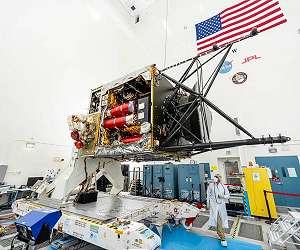In the early solar system, terrestrial planets like Mercury, Venus, Earth and Mars are thought to have formed from planetesimals, small early planets. These early planets grew over time, through collisions and mergers, to make them the size they are today.
The material released from these violent collisions is commonly thought to have escaped and orbited around the sun, bombarding the growing planets and altering the composition of the asteroid belt. But the asteroid belt does not seem to contain a record of this impact debris, which is a mystery that has been stumping astronomers and astrophysicists for decades.
Two researchers from Arizona State University’s School of Earth and Space Exploration, former NewSpace Postdoctoral Fellow Travis Gabriel and doctoral student Harrison Allen-Sutter, were curious about this discrepancy and set about creating high-end computer simulations of the collisions, with surprising results.
“Most researchers focus on the direct effects of impacts, but the nature of the debris has been underexplored,” Allen-Sutter said.
Instead of creating rocky debris, the simulations showed that large collisions between planets vaporize the rocks into gas. Unlike solid and molten debris, this gas more easily escapes the solar system, leaving little trace of these planet-smashing events.
Their work, which has been published in the Astrophysical Journal Letters, provides a potential solution to this decades-old paradox, dubbed the “Missing Mantle Problem” or the “Great Dunite Shortage.”
“It has long since been understood that numerous large collisions are required to form Mercury, Venus, Earth, the moon and perhaps Mars,” said Gabriel, who is the principal investigator of this project. “But the tremendous amount of impact debris expected from this process is not observed in the asteroid belt, so it has always been a paradoxical situation.”
Their results may also help us to better understand how the moon was formed, which is thought to have been born from the aftermath of a collision that released debris into the solar system.
“After forming from debris bound to the Earth, the moon would have also been bombarded by the ejected material that orbits the sun over the first hundred million years or so of the moon’s existence,” Gabriel said. “If this debris was solid, it could compromise or strongly influence the moon’s early formation, especially if the collision was violent. If the material was in gas form, however, the debris may not have influenced the early moon at all.”
Gabriel and Allen-Sutter hope to continue this line of research to learn more about not only our own planets, but also the large population of planets observed outside our solar system.
“There is growing evidence that certain telescope observations may have directly imaged giant impact debris around other stars,” Gabriel said. “Since we cannot go back in time to observe the collisions in our solar system, these astrophysical observations of other worlds are a natural laboratory for us to test and explore our theory.”
Research Report: “Elemental Abundances of the Hot Atmosphere of Luminous Infrared Galaxy Arp 299”
Related Links
ASU School of Earth and Space Exploration
Asteroid and Comet Mission News, Science and Technology
|
We need your help. The SpaceDaily news network continues to grow but revenues have never been harder to maintain. With the rise of Ad Blockers, and Facebook – our traditional revenue sources via quality network advertising continues to decline. And unlike so many other news sites, we don’t have a paywall – with those annoying usernames and passwords. Our news coverage takes time and effort to publish 365 days a year. If you find our news sites informative and useful then please consider becoming a regular supporter or for now make a one off contribution. |
||
|
SpaceDaily Monthly Supporter $5+ Billed Monthly |
SpaceDaily Contributor $5 Billed Once credit card or paypal |
|

![]()
NASA Mission to Asteroid Psyche one year out from launch
Washington DC (SPX) Aug 25, 2021
With NASA’s Psyche mission now less than a year from launch, anticipation is building. By next spring, the fully assembled spacecraft will ship from the agency’s Jet Propulsion Laboratory in Southern California to NASA’s Kennedy Space Center in Florida for a launch period that opens Aug. 1, 2022.
In early 2026, the Psyche spacecraft will arrive at its target, an asteroid of the same name in the main asteroid belt between Mars and Jupiter. Scientists believe asteroid Psyche, which is about 140 mile … read more